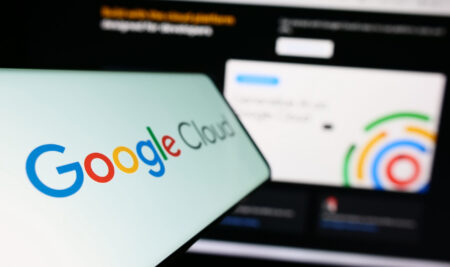
Predicting that a new wave of data-driven application development could trigger the “largest platform enterprise software has ever seen,” Snowflake CEO Frank Slootman believes the rise of business-centric data science is driving the “disintermediation of the entire economy.”
I have great admiration for executives who are able to not only carve out an entirely new category but also transmute that vision into reality, and Slootman recently made a very compelling case for both of those outcomes as part of our CEO Outlook 2023 conversation. This article will cover some of the highlights from that Zoom interview, and you can see the entire discussion here as part of our lead-up to the Cloud Wars Top 10 CEO Outlook Digital Summit taking place on Feb. 8.
Slootman and Snowflake have created and led the massive and fast-growing data-cloud phenomenon that is behind both of those high-scale predictions, and in so doing have forced many of the companies on the Cloud Wars Top 10 to accelerate or revise or enhance or rename their own data-cloud efforts and aspirations.
And if up to this point, the fruits of all of those data-cloud efforts have stirred up great levels of interest, Slootman believes that in 2023 — regardless of however strong the current economic headwinds might become — the phenomenon of data-powered business will exceed breakaway velocity.
The *Real* Significance of “Digital Transformation”
“What’s going on is that this thing we’ve called ‘digital transformation’ — and I pretty much hate that term, because it’s been used a million times with no context, and most people draw a blank when they hear it and don’t know what that even means — but what is real and what it really means and why we are sort of at the heart of that transformation is that we’re helping in disintermediating the entire economy.
“We’re helping companies create direct-to-consumer experiences and to become digital instead physical enterprises. You see it with banks, and with retail, in advertising, and pharmaceuticals,” Slootman said in our mid-January interview.
This upheaval is most certainly not just a technology upgrade or a big jump in efficiency — rather, Slootman said, this data-powered phenomenon is about companies re-imagining their digital futures and building the capabilities to make those dreams come true.
And to illustrate where things are headed, Slootman conjured up the heady metaphor that instead of businesses and other organizations using clouds, businesses are becoming clouds.
Happening Everywhere
“Everywhere you go, this transition is happening,” Slootman said.
“So companies really become clouds: they become software services, and they become experiences that are wholly digital.
“And if you’re going to run an enterprise or an institution like public sector or hospitals or education or whatever, then data becomes absolutely essential.
“That’s the only way you’re going to parse your reality, the only way you’re going to be able to manage your reality, and the only way you’re going to be able to understand your reality.”
That’s the huge bet Snowflake is making: that every mid-sized or large business in every industry in every region of the world will realize it needs to build a “data core” to be able to compete and win in the acceleration economy of today and tomorrow.
And Slootman believes that while some of the tools that journey will require are here or will be soon, much more progress needs to be made across two essential and separate but related areas:
- More changes in the mindsets of more business executives about the pre-eminent role of data inside their organizations and the parallel need for them not to view investments in data as simply more spending on IT stuff; and
- New approaches taken by tech vendors in the data cloud space, with one of those novel approaches lying at the heart of Slootman’s vision for building the “largest platform enterprise software has ever seen”
“This is why people are running so hard to develop data operations that at some base level are going to be capable of delivering those kinds of capabilities,” Slootman said.
“We’re in the middle of that, and that’s why we see some anxiety out there in the marketplace. It’s more intense in some geographies and across different verticals, but everybody’s feeling it.
The Power of Data Science
“There is a huge gap between organizations that are born-in-the-cloud digital natives versus some other people that can’t even spell data science.”
For those with the spelling challenge, it’s a case of, well, not exactly some “good” news and some bad news, but rather having one final chance (which in a sense is good news) with a very good chance of survival — if they play into the trend.
“The disintermediation means that these older companies like banks and insurance companies have to have a one-to-one relationship with their end customers. I mean, look at media — even today, there are still some media companies like Fox who are selling through cable operators,” Slootman said.
“But most media companies have built those one-to-one relationships with the people who subscribe to their services because they have to have that so they can know about those people and be able to upsell them or cross-sell them to optimize their pricing models.
“This is a huge, huge thing for businesses in today’s data world,” Slootman said.
And that same inescapable dynamic is at play in the public sector as well.
“In government, you have these very highly populated organizations that will become, in the fullness of time, public-service clouds able to deliver the whole experience in a digital fashion. We’re seeing that already in Europe more so than you do in the U.S.”
[Note to self — beautiful use of the phrase “in the fullness of time” — have to borrow that one sometime!]
Data Modernization *and* Mindset Modernization
So as businesses as well as public-sector entities look to give their customers/constituents what they want and are increasingly demanding — one-to-one relationships — those enterprises need full access to all relevant data in order to be able to deliver great experiences. But as noted above, modern technology is only one factor in the equation.
What Snowflake’s customers have to bring to bear, Slootman said, is a mindset built around relentlessly improving processes, insights, and outcomes by having access to the latest and best tech capabilities.
“We are continually updating and refreshing our software on a relatively short schedule. And some major customers see that and are like, ‘Whoa, whoa, whoa’ — that’s what they call ‘pinning,’ where executives who like to stick with the old ways of doing things say, ‘I want you to just hold me in place for this period of time or that period of time.’ ”
At this point, I get the impression that Slootman, while highly sensitive to the challenges customers with old technology face in modernizing the tech side of their data estates, is less than completely sympathetic when business leaders go through the motions of saying they’ll commit to big changes to become data-centric organizations, but fail to follow through vigorously and consistently.
“So we tell them that first of all, that’s actually physically impossible in a multi-tenant environment — and by the way, it’s not in your interest, either, because when you stay behind, you introduce all kinds of risk and exposure doing it that way,” Slootman said.
“But these conversations are hard because these executives are used to an on-premise world where, for example, at Christmas season they say, ‘I’m just freezing things as they are — I’m not opening things up again until January 15 or February 15 or whatever.’
“And we tell them, ‘Those days are gone.’ ”
On the flip side, for businesses willing to make cultural changes as well as technological modernization, the results can be…well, simply intoxicating.
Pent-up Demand, Meet Cool New Capability
“One of the super interesting things about the Snowflake business — and I tried to explain this to the Wall Street crowd as well — is that we don’t so much create demand as that we enable it, which is a completely different thing,” Slootman said.
“The demand was already there — but the architectures of the past were incapable of enabling it. It used to be that someone had to beg for a business analyst to give them a 2:30 am time slot three months from now” to run a query.
“So most people were like, you know, ‘Okay, I give up.’
“And it was only the very small set of the top-priority totally essential 24-hour-cycle type of processing where a few people would come in the morning and maybe by 9:00 am, they have something to look at and they can refresh dashboards and all that kind of stuff.”
That sounds like a sure-fire recipe for disaster in today’s world, and Slootman said businesses that experience the new power of real-time data and queries and hands-on engagement are changing the way those businesses operate—and the nature of future opportunities they can create.
“Now it’s like, ‘Wait a second — I can just, I can just turn on a new cluster, and it’s running like a bat outta hell! And I’m gonna have results in minutes instead of hours or days.’
“So it’s intoxicating, right? I was talking about this with the chief data officer at a large media company and she said to me, ‘Now I need to pass out drink tickets, because my people are getting wasted on Snowflake.’ ”
But setting aside the intoxication for a moment, the other huge insight shared by Slootman is that no matter how successful Snowflake has been up to this point — last quarter, revenue grew 67% to $523 million — the fast-changing business world is mandating that what got us here will not get us where we need to go.
‘Picking Up the Scent’
As business leaders understand the full power of the data they have — or have access to — they’ll see it as not only the world’s most valuable resource but as a springboard to massive new opportunities.
“Correlation doesn’t lie, and data doesn’t lie, and data doesn’t have opinions — it just says what it is,” Slootman said.
“And then you can run all the subsequent analyses on discovering, ‘Well, why is that?’ And you can find if it’s correlation or causation, which is an enormous discovery…. This is why I said why it’s so super important to not silo the data, because the moment you do that, you can’t discover these relationships,” he said.
“So the whole notion of data sharing becomes really important, as does bringing in all the different data from different data sources.
“And people have picked up the scent of this opportunity and are running after it — they may not know exactly when and where, but they know approximately where it is. And it’s almost like like a gold rush, right?
“We know it’s out there — and we’re going to be drilling for it.”
But as important as that drilling for the data is, it’s no longer enough on its own. Because as that data culture takes hold and the panning for gold leads to an analysis of where to find still more riches and more value, the inevitable next step will be a separate but related category into which Snowflake is moving very aggressively: being a platform for applications development.
‘Unleashing the World’s Creativity’
That move is “a natural evolution,” Slootman said, because the data being surfaced — and the insights gleaned from the data — are ideal ingredients for new applications.
As Snowflake works with ever-increasing numbers and types of workloads, “We see all things of all kinds, and one of the things we saw is that more and more people are saying, ‘Hey, we’re not just running these big batch analytical operations that populate reports and dashboards — and in fact, we want to build customer-facing applications that use this data,’ ” he said.
While that caught Snowflake a bit off-guard at first, Slootman and his team quickly saw and embraced a massive opportunity to, as he ambitiously phrased it, “unleash the world’s creativity.”
“We were like, ‘Holy cow, you want to build applications? What does that require? What do we have to do here?’
“Well, turns out there’s an awful lot we have to do. And that’s what we literally been working on here for almost four years and we’ve been pouring on the resources to really build Snowflake into a cloud application development and runtime platform.”
Slootman emphasized that apps written on the Snowflake platform can run “unmodified” on the three biggest clouds — Amazon, Microsoft, and Google — and of course on both iOS and Android.
And that evolution has caused Snowflake to completely rethink the value it can deliver to customers, and how it should position itself in a wickedly competitive market.
“To us, data or data warehousing is just a workload now, okay, and it’s just a feature set—it is no longer a market,” Slootman said in the broader context of how across the tech sector, “markets are morphing and the boundaries are being redrawn.
“When you get close to it, you may not see that, but if you sort of pull away a little bit, you see that this is turning into a massive platform environment, and it might be the largest platform that we’ve ever seen in enterprise software,” he said.
With the chance that millions of data enthusiasts and some non-techy businesspeople will become at least part-time creators of apps that can drive enormous advances in business insights and productivity and innovation, the result is an opportunity that appeals to the hyper-aggressive and rigorously focused Slootman.
“And I believe this represents a great chance for unleashing the world’s creativity.”
The full-length CEO Outlook version of this interview is available exclusively to Acceleration Economy subscribers. Sign up here for the CEO Outlook Digital Summit to start your free subscription and see all of the Cloud Wars Top 10 CEO Outlook interviews that will air on February 8, 2023, or upgrade to Premium and get your all-access pass to our entire practitioner analyst library of content.








